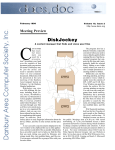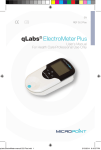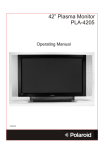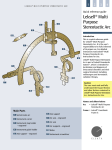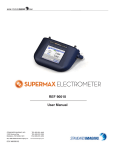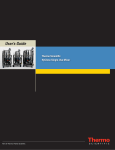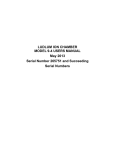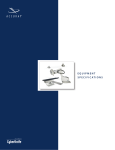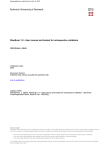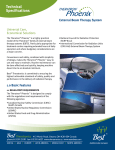Download REF 92739 - Tecnologie Avanzate
Transcript
WWW. .COM REF 92739 STANDARD IMAGING, INC. 3120 Deming Way Middleton, WI 53562-1461 TEL 800.261.4446 TEL 608.831.0025 FAX 608.831.2202 Aug / 2012 ©2012 Standard Imaging, Inc. DOC #80643-01 #80XXX-00 General Precautions Warnings and Cautions alert users to dangerous conditions that can occur if instructions in the manual are not obeyed. Warnings are conditions that can cause injury to the operator, while Cautions can cause damage to the equipment. WARNING: Proper use of this device depends on careful reading of all instructions and labels. WARNING: Where applicable, Standard Imaging products are designed to be used with the versions of common radiation delivery devices, treatment planning systems and other products or systems used in the delivery of ionizing radiation, available at the time the Standard Imaging product is released. Standard Imaging does not assume responsibility, liability and/or warrant against, problems with the use, reliability, safety or effectiveness that arise due to the evolution, updates or changes to these products or systems in the future. It is the responsibility of the customer or user to determine if the Standard Imaging product can be properly used with these products or systems. WARNING: The Exradin W1 Scintillator is intended for quality assurance and calibration measurements. It is not intended to be connected to a patient for real-time dosimetry measurements. CAUTION: For valid measurement results using the Exradin W1 Scintillator, the spectral filtration method described in this manual must be used. CAUTION: Do not drop, mishandle, or disassemble the Exradin W1 Scintillator. Refer all servicing to qualified individuals. CAUTION: The Exradin W1 Scintillator can be used with non-Standard Imaging electrometers with sub-pA resolution. However, do not apply HV bias to the Scintillator triaxial connectors or damage to the electrometer may result. CAUTION: The Exradin W1 Scintillator is optimized for use with the SuperMAX Electrometer (ref 90018). If using the Exradin W1 Scintillator with electrometers other than the SuperMAX, measurement performance may vary. ii CAUTION: When using the Exradin W1 Scintillator with two separate electrometers, timing differences between electrometers can affect measurement results. CAUTION: The photodiode enclosure or triaxial connectors should never be submerged in any liquid, scrubbed with an abrasive cleaner, or be stored or placed where liquids could be spilled or splashed onto it. CAUTION: Do not apply high voltage (HV) bias voltage to the Exradin W1 Scintillator. Damage to the device or the electrometer may occur. CAUTION: Keep photodiode enclosure away from beam during measurements. CAUTION: Ensure the channels of the Exradin W1 Scintillator are always properly connected to the electrometer(s). Inaccurate measurements will occur if the channels are swapped. CAUTION: Signal degradation can occur - with accumulated dose. Ensure detector readings are within the desired measurement certainty. CAUTION: Do not kink or subject the optical fiber to a bend radius smaller than that of the calibration slab. Damage to the fiber or alteration of the measurement signal may occur. CAUTION: Do not attempt to remove the optical fiber from the photodiode enclosure. CAUTION: Do not sharply bend triaxial cable. Damage to the cable may result in high leakage currents. Table of Contents 1 Product Overview 1Introduction 2 Theory of Operation 3 Physical Description 4 Use with SuperMAX Electrometer 5 General Operation 5 3120 DEMING WAY Connecting the Exradin W1 Scintillator MIDDLETON, WI 53562-1461 USA to an Electrometer WWW.STANDARDIMAGING.COM 6 Positioning the Photodiode Enclosure 6 Care and Handling of the Optical Fiber 7 Using the Exradin Scintillator Calibration Slab 9 Establishing Baselines 12 Calculating Baseline CLR and Gain Values 13 Applying Baseline Values to General Measurements 14Bibliography 16Maintenance 17 Triaxial Connector Cleaning Procedure 18 Parts and Accessories 18 Features and Specifications 21 Service Policy 21 Customer Responsibility 22Warranty Product Overview Introduction The Exradin W1 Scintillator is a plastic scintillating fiber-based detector designed for highly accurate measurement of small radiotherapy fields used in patient plan verification and machine commissioning and QA procedures. The benefits of this type of detector are well documented1,2,3,4 and include near water equivalence, linear dose as well as dose rate response, energy independence within the MV range and above 125 keV and temperature independence within the operating range (see Features and Specifications section). The geometry of the Exradin W1 Scintillator in particular provides excellent spatial resolution and is ideal for characterizing and measuring fields used for stereotactic radiosurgery (SRS) and stereotactic body radiation therapy (SBRT). 1 Product Overview continued Theory of Operation The passage of ionizing radiation through a scintillating material excites the atoms of that material to a short-lived excited state. When the atoms decay to their ground state, they emit photons, which in this case are in the visible light spectrum. These photons are collected by a photodetector and that signal is measured by an electrometer. However, Čerenkov emissions5 are also created when the optical fiber used to couple the scintillating material to the photodiode is irradiated. The amount of light produced is proportional to the irradiated length of the optical fiber, and measurement results must be corrected to account for this phenomenon. While it has been shown6 that spectral filtration will not completely remove the Čerenkov light, this filtration method nevertheless provides a high level of accuracy in correcting measurements for the effect of Čerenkov radiation7. To achieve this correction, baseline measurements must be performed using a large fixed field and two different optical fiber configurations. As proposed by Fontbonne et al8, explicitly formulated by Frelin et al9, and specifically demonstrated for plastic scintillating fibers by Guillot et al7, Gain and Čerenkov Light Ratio (CLR) values are calculated from this baseline, and these can be applied to subsequent measurements to compensate effectively for the Čerenkov effect. Furthermore, additional scintillator and reference ion chamber measurements can be incorporated into the baseline to facilitate conversion of relative scintillator readings to dose units. 2 Product Overview continued Physical Description Exradin W1 Scintillator Exradin Scintillator Calibration Slab Alignment Cap The Exradin W1 Scintillator is comprised of three main components: 1. Plastic scintillating fiber 2. Optical fiber 3. Shielded enclosure housing a photodiode with two discrete triaxial connectors The sensitive portion of the detector is a 1 mm diameter x 3 mm length of polystyrene-based scintillating fiber that has been carefully optimized for ideal scintillation, optical, radiationresistance, and dosimetric characteristics. The photodiode is mounted within a shielded enclosure designed to minimize noise created from ambient radiation present during typical use. Two triaxial connectors provide the current output from the blue and green spectral measurement regions of the photodiode. While other electrometers can be used, the Exradin W1 Scintillator is specifically designed and optimized for use with the SuperMAX Electrometer (ref 90018) available from Standard Imaging. The SuperMAX Electrometer features software to assist in management of baseline values as well as real-time corrections for display of relative measurements or dose readings from the Exradin W1 Scintillator. As the SuperMAX is a synchronized two channel instrument, timing issues that can result from the use of multiple discrete electrometers are effectively eliminated. 3 Product Overview continued The Exradin Scintillator Calibration Slab is provided in acrylic or Virtual Water™ material, depending on the configuration purchased. The Calibration Slab ensures repeatable baseline positioning of the Exradin W1 Scintillator, and enables the most accurate subtraction of Čerenkov light from Scintillator light in typical use situations. Purchase of either the acrylic or Virtual Water version of the Scintillator Calibration Slab is therefore required when purchasing the Exradin W1 Scintillator. Finally, an alignment cap is included to assist users in accurately locating the center of the scintillating fiber when positioning the Exradin W1 Scintillator in air or in a water phantom. Note that this cap is designed solely for alignment and not intended for use as build-up for any specific energy. Virtual Water is a trademark of Med Cal. Use with SuperMAX Electrometer Version 2.0 and later of Standard Imaging SuperMAX Electrometer software greatly enhances use of the Exradin W1 Scintillator. The 2 channel SuperMAX incorporates a baseline creation and database tool as well as a dedicated measurement mode to display real-time, merged and corrected readings from the Exradin W1 Scintillator. For specific operating instructions on using these modes, see the SuperMAX user manual. For more information about upgrading a pre-version 2.0 SuperMAX to the latest version, contact Standard Imaging. 4 General Operation Connecting the Exradin W1 Scintillator to an Electrometer The Exradin W1 Scintillator connects to an electrometer in a similar fashion to other radiation quality assurance detectors such as an ion chamber or diode. Included with the Exradin W1 Scintillator are triaxial adapters which convert the connector gender for use with most standard triaxial extension cables. Before connecting the Exradin W1 Scintillator to an electrometer, ensure there is no bias voltage being applied to the electrometer’s triaxial connector as this can damage the electrometer. Furthermore, ensure no bias is applied at any time during the measurement as the Exradin W1 Scintillator is designed for use with no bias voltage applied to the detector. Both connectors on the Exradin W1 Scintillator photodiode enclosure must be used. If using a SuperMAX Electrometer, connect each channel of the scintillator to the corresponding channel on the SuperMAX. If using another electrometer or electrometers, it is imperative to note which scintillator channel is used with which electrometer connector for later reference. Always perform a system zero before continuing to remove any offsets that may be present. Triaxial Adapter Cables Standard Triaxial Cables SuperMAX Electrometer 5 General Operation continued Positioning the Photodiode Enclosure The Exradin W1 Scintillator photodiode enclosure can be a source of relative measurement noise. For best results, always maximize the distance between the enclosure and the field of measurement. It is recommended to evaluate the noise contribution with any new measurement setup to ensure a satisfactory signal to noise ratio. An ideal method for determining noise is to place the enclosure in the desired location, place the scintillator well outside of the measurement field, deliver the intended field, and acquire an electrometer reading. Next, place the scintillator in the desired measurement location, perform a similar reading and compare the two results to determine the contribution of noise. Once the noise level has been determined, ensure it is acceptable for the desired signal to noise ratio. Position of the enclosure from measurement to measurement is also important. It is recommended to try to replicate the position of the enclosure relative to the beam when transitioning from baseline measurements to general measurements. Differences in position can contribute to uncertainty in measurement results, particularly for low signal conditions. Care and Handling of the Optical Fiber The Exradin W1 Scintillator utilizes a plastic optical fiber to transfer the scintillating signal to the photodiode. This optical fiber is robust; however it is sensitive to crushing, kinking, or small bend radii. Avoid circumstances where these perils could occur as permanent damage to the fiber will result. The optical fiber makes use of the property of total internal reflection to transmit light along its length, and the transmission efficiency is dependent on the bend radius of the fiber. The plastic optical fiber used in the Exradin W1 Scintillator was carefully chosen to minimize this effect, however it is important to avoid bend radii smaller than that on the Calibration Slab to minimize measurement perturbation. 6 General Operation continued Using the Exradin Scintillator Calibration Slab For performing baseline measurements or for regular use in water equivalent phantoms, the Exradin Scintillator Calibration Slab is designed to position the Exradin W1 Scintillator reliably in one of two repeatable configurations, for which the only difference is the magnitude of Čerenkov emissions. The two configurations are as follows: Max Fiber: The maximum fiber configuration is used for performing specific baseline measurements. Min Fiber: The minimum fiber configuration is used for performing specific baseline measurements as well as general measurements in a phantom setup. 7 General Operation continued Setting Up the Calibration Slab 1. Place the Exradin W1 Scintillator into the base slab using the desired configuration: min or max fiber. 2. Use the crosshairs and 10 cm alignment lines on the base slab to position it in the field. 10 cm 10 cm 8 General Operation continued 3. Place the cover slab on top. When assembled the, the Exradin W1 Scintillator is centered with the total thickness of 2 cm.. Assembled MinMax When acquiring measurements for baseline Čerenkov correction(s), no additional buildup above or below the calibration slab is required, however additional water equivalent material may be used depending on the desired setup and energy. For good response, it is recommended to be at or beyond dmax. When acquiring dose baselines, the setup should match that used for ion chamber measurement(s). Establishing Baselines Before general measurement use, initial measurements must be performed to calculate baseline Čerenkov Light Ratio (CLR) and Gain values which are applied to subsequent readings. There are two types of baselines: relative and dose. The CLR is the same for either a relative or dose baseline, but the Gain value is different for each. Measurements required for each baseline are performed using the Exradin Scintillator Calibration Slab and the two Exradin W1 Scintillator configurations described in the preceding section. Once baseline values have been calculated using the calibration slab, the Exradin W1 Scintillator may be used for general measurements in air or in plastic or water phantoms. The validity of baselines over a period of time or exposure to dose can vary depending on usage. Čerenkov correction calibrations should be completed on a regular basis and evaluated to ensure validity for the intended use and to compensate for radiation degradation of the scintillating material, optical fiber, and photodiode that occurs with accumulated dose. In general, an updated baseline should be established after approximately every 1 kGy of dose delivery. With frequent Čerenkov correction calibrations, the effects on the accuracy of the device can be managed, however the signal-to-noise ratio will decrease with long term or extremely high dose exposure. Please contact Standard Imaging for replacement of the sensor assembly if needed. 9 General Operation continued The following instructions describe the recommended configurations and procedures for the two baseline types, relative and dose. Performing Baseline Measurements Refer to the following table for the measurements to be performed for relative and dose baseline types. Both types require measurements to be acquired at 40x40 cm² field size, while the dose type requires additional 10x10 cm² field size measurements. A 10x10 cm² measurement should also be acquired with a calibrated ion chamber placed in a phantom configuration matching that of the assembled calibration slab and any other build-up and backscatter material used for the dose baseline type. Calibration Slab Configuration Field Size Detector Position Relative and Dose Max Fiber 40x40 cm² Isocenter Exradin W1 Scintillator At least 1 (3 or more recommended) Relative and Dose Min Fiber 40x40 cm² Isocenter Exradin W1 Scintillator At least 1 (3 or more recommended) Dose only Min Fiber 10x10 cm² Isocenter Exradin W1 Scintillator At least 1 (3 or more recommended) Dose only n/a 10x10 cm² Isocenter Absolute calibrated ion chamber At least 1 (3 or more recommended) Baseline Type 10 Detector # of Measurements General Operation continued 1. Insert the Exradin W1 Scintillator into the calibration slab using the desired configuration and place the assembled slab at isocenter with the desired field size, either 10x10 cm² or 40x40 cm². When the electrometer and cables are set up, follow the electrometer manufacturer’s recommended settling time, warm-up and zeroing procedures. Do not apply bias to the Exradin W1 Scintillator. 2. Perform a simultaneous acquisition on each Exradin W1 Scintillator channel. The amount of delivery should be enough to account for the desired measurement certainty: at least 100 MU is recommended. Additional acquisitions can be performed and averaged to increase certainty. NOTE: When using the SuperMAX Electrometer, the Scintillator Baseline Library mode can be used to automate the process of recording and organizing these values. See the SuperMAX Electrometer user manual for additional information. If not using the SuperMAX Electrometer, record all measurement values for performing the baseline calculations outlined in the “Calculating Baseline CLR and Gain Values” section of this manual. 3. Repeat steps 1 and 2 until the desired measurements are acquired for all field size and calibration slab configurations. Use the same delivery and acquisition parameters for all measurements to be used in the baseline calculation. Additional build-up and backscatter material can be added for the 10x10 cm² field, Min Fiber configuration. 4. Dose type only - Setup a calibrated ion chamber in a phantom configuration matching that of the assembled calibration slab and any other build-up and backscatter material used. When the electrometer and cables are set up, follow the electrometer manufacturer’s recommended settling time, warm-up and zeroing procedures. 5. Dose type only - Deliver an MU quantity matching that used for the scintillator measurements. Additional acquisitions can be performed and averaged to increase the measurement certainty. 6. Dose type only - Using the desired protocol and measurement standard, convert the measurement from step 5 to dose. NOTE: When using the SuperMAX Electrometer, the calculated dose value can be entered in the Scintillator Baseline Library mode using the following units: MU, Gy, cGy, R and mR. See the SuperMAX Electrometer user manual for additional information. 11 General Operation continued Calculating Baseline CLR and Gain Values If using the SuperMAX Electrometer, these values are calculated automatically using the Scintillator Baseline Library interface. For specific operating instructions describing use of this mode, see the SuperMAX user manual. Algorithms Used by SuperMAX Electrometer Once measurements have been acquired using the preceding procedures, calculate the Čerenkov Light Ratio (CLR) and Gain values using the following formulas: •• CLR = (SC1MAX40 – SC1MIN40) / (SC2MAX40 – SC2MIN40) •• Gain (relative) = 1 / (SC1MIN40 – SC2MIN40 * CLR) •• Gain (dose) = Dose10 / (SC1MIN10 – SC2MIN10 * CLR) Variable Definition: •• CLR: Čerenkov Light Ratio •• Gain (relative): Gain value used for performing relative measurements •• Gain (dose): Gain value used for performing dose measurements •• SC1MAX40: Scintillator Channel 1 measurement, max fiber configuration, 40x40 cm² field size •• SC2MAX40: Scintillator Channel 2 measurement, max fiber configuration, 40x40 cm² field size •• SC1MIN40: Scintillator Channel 1 measurement, min fiber configuration, 40x40 cm² field size •• SC2MIN40: Scintillator Channel 2 measurement, min fiber configuration, 40x40 cm² field size •• SC1MIN10: Scintillator Channel 1 measurement, min fiber configuration, 10x10 cm² field size •• SC2MIN10: Scintillator Channel 2 measurement, min fiber configuration, 10x10 cm² field size •• Dose10: Dose measurement, 10x10 cm² field size 12 General Operation continued Applying Baseline Values to General Measurements If using the SuperMAX Electrometer, baseline values are applied automatically using the Scintillator Measurement interface. For specific operating instructions describing use of this mode, see the SuperMAX user manual. Algorithm Used by SuperMAX Electrometer Once baseline values have been established, resultant gain and CLR values can be applied to general measurements using the following formula: Measurement = Gain * (SC1 – SC2 * CLR) Variable Definition: •• Gain: Relative or dose baseline gain value •• CLR: Čerenkov Light Ratio •• SC1: Reading from Scintillator Channel 1 •• SC2: Reading from Scintillator Channel 2 13 Bibliography References Lacroix F, Archambault L, Gingras L, Beddar AS, and Beaulieu L. Clinical prototype of a plastic water equivalent scintillating fiber dosimeter matrix for IMRT QA applications, Med. Phys. 35: 3682-3690, 2008. Archambault L, Beddar S, Gingras L, Lacroix F, Roy R, Beaulieu L, “Water-equivalent dosimeter array for small-field external beam radiotherapy”, Med Phys 34: 1583–1592, 2007. Archambault L, Arsenault J, Gingras L, Beddar A S, Roy R, Beaulieu L, “Plastic scintillation dosimetry: Optimal selection of scintillating fibers and scintillators“, Med. Phys. 32: 2271-2278, 2005. Beddar S, Kinsella T J, Ikhlef A, Sibata C H, “Miniature ‘Scintillator-Fiberoptic-PMT’ detector system for the dosimetry of small fields in stereotactic radiosurgery”, IEEE Trans. Nucl. Sci. 48: 924-928, 2001. A. S. Beddar, T.R. Mackie, and F.H. Attix, “Cerenkov light generated in optical fibres and other light pipes irradiated by electron beams,” Phys. Med. Biol. 37: 925–935, 1992. de Boer S F, Beddar A S Rawlinson J F, “Optical filtering and spectral measurement of radiation induced light in plastic scintillator dosimetry“, Phys Med Biol 38: 945-958, 1993. M. Guillot, L. Gingras, L. Archambault, S. Beddar, and L. Beaulieu, “Spectral method for the correction of the Cerenkov light effect in plastic scintillation detectors”, Med. Phys. 38: 2140-2150, 2011. J.M. Fontbonne, G. Iltis, G. Ban, A. Battala, J. C. Vernhes, J. Tillier, N. Bellaize, C. Le Brun, B. Tamain, K. Mercier, and J. C. Motin, “Scintillating fiber dosimeter for radiation therapy accelerator,” IEEE Trans. Nucl. Sci. 49: 2223–2227, 2002. A.M. Frelin, J.M. Fontbonne, G. Ban, J. Colin, M. Labalme, A. Batalla, A. Isambert, A. Vela, and T. Leroux, “Spectral discrimination of Cerenkov radiation in scintillating dosimeters,” Med. Phys. 32: 3000–3006, 2005. 1 2 3 4 5 6 7 8 9 14 Bibliography continued Additional Information Gagnon JC, Theriault D, Guillot M, Archambault L, Beddar S, Gingras L, Beaulieu L. Dosimetric performance and array assessment of plastic scintillation detectors for stereotactic radiosurgery quality assurance. Med Phys 39(1):429-436, 1/2012 Beddar AS, Mackie TR, Attix FH. Water-equivalent plastic scintillation detectors for highenergy beam dosimetry: I. Physical characteristics and theoretical consideration. Phys Med Biol 37(10):1883-900, 1992. Beddar AS, Mackie TR, Attix FH. Water-equivalent plastic scintillation detectors for highenergy beam dosimetry: II. Properties and measurements. Phys Med Biol 37(10):190113, 1992. Archambault L, Arsenault J, Gingras L, Beddar AS, Roy R, and Beaulieu L. Plastic scintillation dosimetry: optimal selection of scintillating fibers and scintillators. Med Phys 32:2271-2278,2005. Lacroix F, Beaulieu L, Archambault L, Beddar AS. Simulation of the precision limits of plastic scintillation detectors using optimal component selection. Med Phys 37(2):412418, 2/2010. Lacroix F, Guillot M, McEwen M, Cojocaru C, Gingras L, Beddar AS, Beaulieu L. Extraction of depth-dependent perturbation factors for parallel-plate chambers in elecron beams using plastic scintillation detector. Med Phys 37(8):4331-4342, 8/2010. 15 Maintenance Exterior cleaning of the Exradin W1 Scintillator and accessories can be performed with a soft brush or cloth. Gently brush all surfaces to remove dirt and dust. Be especially careful that this is an external cleaning only and do not permit any liquid to seep into the Exradin W1 Scintillator photodiode enclosure in any manner during cleaning. To clean the triaxial connectors, refer to the procedure in the following section. There are no user serviceable parts on the Exradin W1 Scintillator. Under no circumstance should the user attempt to repair or disassemble the scintillator, photodiode enclosure, and/or connectors, as the warranty will become void. Radiation degradation of the scintillating material, optical fiber, and photodiode will occur with accumulated dose. With timely Čerenkov correction calibrations, the effects on the accuracy of the device can be managed, however the signal-to-noise ratio will decrease with accumulated dose. The Exradin W1 Scintillator was designed for replacement of the sensor assembly. Please contact Standard Imaging for more information. If assistance is desired in the proper disposal or recycling of this product (including accessories and components), after its useful life, please return to Standard Imaging. 16 Maintenance continued Triaxial Connector Cleaning Procedure This procedure should be periodically completed or whenever there are concerns of drift or leakage. Heavier product use may require more frequent cleanings. Prior to cleaning a triaxial connector, ensure: •• The scintillator is disconnected from the electrometer. •• There is no water or moisture visible in the triaxial connector. To clean a dirty triaxial connector: •• Remove the connector cap (if applicable). •• Use only a dry and oil free compressed air source, such as Chemtronics® Ultra Jet. •• Gently blow dirt and contaminants from the inside of the connector, moving the air source in a circular manner a few inches from the connector. After cleaning a dirty triaxial connector: •• Use the connector cap when not in use (if applicable). Do not: •• Use sharp objects to attempt to clean a dirty triaxial connector. •• Use a compressed gas other than air. •• Use a compressed gas source that may have moisture or oil in the source or lines. •• Use your mouth to blow on the connector. •• Disassemble the connector. •• Touch the internal parts of the connector with your finger. If this procedure does not resolve the drift or leakage issues, contact the Standard Imaging for further assistance. 17 Parts and Accessories REFDescription 92739 Exradin W1 Scintillator 31456 Exradin W1 Scintillator Alignment Cap 75011 Exradin Scintillator Calibration Slab (acrylic) 75012 Exradin Scintillator Calibration Slab (Virtual Water) R320-Cd Virtual Water Phantom, 30x30x2 cm with drilled cavity for ion chamber 70096-C34 Lucy 3D QA Phantom Exradin W1 Scintillator Dosimetry Insert 70006-AA BNC 2-lug Triaxial Adapter Cable 70006-AC TNC 2-lug Triaxial Adapter Cable 80643 Exradin W1 Scintillator User Manual 90018 SuperMAX Electrometer Features and Specifications Exradin W1 Scintillator Dimensions: Scintillating fiber: 1.0 mm diameter x 3.0 mm long Scintillator housing: 2.8 mm diameter x 42 mm long Optical fiber: Photodiode enclosure (LxWxH): Weight: 1.0 mm diameter core x 2.2 mm diameter jacket x 3 m long 80 x 46 x 30 mm 0.34 kg (0.75 lbs) Materials: Scintillating fiber: Polystyrene with fluorescent dopants Optical fiber: Scintillator enclosure: Optical fiber minimum bend radius: Scintillating fiber physical density: 1.05 g/cm³ Nominal response: 60 pC / Gy Radiation degradation: ~ 2% / kGy 18 Acrylic (PMMA) with Polyethylene jacket Epoxy potted within an ABS plastic tip and polyimide stem 6 cm Features and Specifications continued Exradin Scintillator Calibration Slab Dimensions: Lid (LxWxH): Base (LxWxH): Assembled (LxWxH): Crosshair alignment lines: Weight (assembled): Materials: 300 x 300 x 8.5 mm 300 x 300 x 11.5 mm 300 x 300 x 20 mm 10 x 10 cm 2.15 kg (4.75 lbs) Acrylic or Virtual Water General Operating parameters: Pressure: Temperature: Relative humidity: Storage parameters: Pressure: Temperature: Relative humidity: Patent: Product standards: 650 to 770 mm Hg 15 to 30 °C 20 to 80% 600 to 800 mm Hg -15 to 50 °C 10 to 95%, non-condensing US Patent Number 8183534 IEC 60601-11, 1 - Authorized representative for the EU is AMA, Ltd., St. Felix House, Flitcham, King’s Lynn, Norfolk, United Kingdom, PE31 6BU. - Competent Authority for the EU is the Medical Products Agency, Sweden. - Notified Body for the EU is Semko, Sweden. Designed to meet 19 Notes 20 Service Policy Customer Responsibility If service, including recalibration, is required, please contact Standard Imaging’s Customer Service department by phone or email prior to shipping the product. Standard Imaging’s Customer Service and Technical Service staff will attempt to address the product issue via phone or email. If unable to address the issue, a return material authorization (RMA) number will be issued. With the RMA number, the product can be returned to Standard Imaging. It is the responsibility of the customer to properly package, insure and ship the product, with the RMA number clearly identified on the outside of the package. The customer must immediately file a claim with their carrier for any shipping damage or lost shipments. Return shipping and insurance is to be pre-paid or billed to the customer, and the customer may request a specific shipper. Items found to be out of warranty are subject to a minimum service fee of 1 hour labor (excluding recalibrations) for diagnostic efforts and require a purchase order (PO) before service is performed. With concurrence from customer, the product may be replaced if it is unserviceable or if the required service is cost prohibitive. Products incurring service charges may be held for payment. Standard Imaging does not provide loaner products. See the Standard Imaging Warranty and Customer Responsibility for additional information. This product and its components will perform properly and reliably only when operated and maintained in accordance with the instructions contained in this manual and accompanying labels. A defective device should not be used. Parts which may be broken or missing or are clearly worn, distorted or contaminated should be replaced immediately with genuine replacement parts manufactured by or made available from Standard Imaging Inc. Serialization Information Standard Imaging products that are serialized contain coded logic in the serial number which indicates the product, day and year of manufacture, and a sequential unit number for identification: A YY DDD X A YY Unique product ID Last two digits of the year (e.g. 1999 = 99, 2000 = 00) DDD Day of the year (1< DDD < 365) X Unique unit ID Number (1 < X < 9) CAUTION: Federal law in the U.S.A. and Canadian law restrict the sale, distribution, or use of this product to, by, or on the order of a licensed medical practitioner. The use of this product should be restricted to the supervision of a qualified medical physicist. Measurement of high activity radioactive sources is potentially hazardous and should be performed by qualified personnel. CAUTION: As desired by IAEA, English is the default language for labeling and manuals. If translated versions are available, resolve any differences in favor of the English versions. WARNING: Proper use of this device depends on careful reading of all instructions and labels. WARNING: Where applicable, Standard Imaging products are designed to be used with the versions of common radiation delivery devices, treatment planning systems and other products or systems used in the delivery of ionizing radiation, available at the time the Standard Imaging product is released. Standard Imaging does not assume responsibility, liability and/or warrant against, problems with the use, reliability, safety or effectiveness that arise due to the evolution, updates or changes to these products or systems in the future. It is the responsibility of the customer or user to determine if the Standard Imaging product can be properly used with these products or systems. Should repair or replacement of this product become necessary after the warranty period, the customer should seek advice from Standard Imaging Inc. prior to such repair or replacement. If this product is in need of repair, it should not be used until all repairs have been made and the product is functioning properly and ready for use. After repair, the product may need to be calibrated. The owner of this product has sole responsibility for any malfunction resulting from abuse, improper use or maintenance, or repair by anyone other than Standard Imaging Inc. The information in this manual is subject to change without notice. No part of this manual may be copied or reproduced in any form or by any means without prior written consent of Standard Imaging Inc. 21 Warranty Standard Imaging, Inc. sells this product under the warranty herein set forth. The warranty is extended only to the buyer purchasing the product directly from Standard Imaging, Inc. or as a new product from an authorized dealer or distributor of Standard Imaging, Inc. For a period provided in the table below from the date of original delivery to the purchaser or a distributor, this Standard Imaging, Inc. product, provided in the table is warranted against functional defects in design, materials and workmanship, provided it is properly operated under conditions of normal use, and that repairs and replacements are made in accordance herewith. The foregoing warranty shall not apply to normal wear and tear, or if the product has been altered, disassembled or repaired other than by Standard Imaging, Inc. or if the product has been subject to abuse, misuse, negligence or accident. Product Warranty Period ADCL Product Calibration (Standard Imaging uses the UW-ADCL for recalibrations required under warranty, unless otherwise requested) 0 - 90 days = 100% of ADCL Calibration Costs 91 - 182 days = 75% of ADCL Calibration Costs 183 – 365 days = 50% of ADCL Calibration Costs 366 – 639 days = 25% of ADCL Calibration Costs (days from date of shipment to customer) Standard Imaging Ionization Chambers Standard Imaging Well Chambers Standard Imaging Electrometers Standard Imaging BeamChecker Products Standard Imaging Software Products All Other Standard Imaging Products Standard Imaging Custom Products Standard Imaging Remanufactured Products Standard Imaging Custom Select Products Consumables Serviced Product Resale Products 2 years 2 years 5 years 2 years 1 year 1 year 1 year 180 days 90 days 90 days 90 days As defined by the Original Equipment Manufacturer Standard Imaging’s sole and exclusive obligation and the purchaser’s sole and exclusive remedy under the above warranties are, at Standard Imaging’s option, limited to repairing, replacing free of charge or revising labeling and manual content on, a product: (1) which contains a defect covered by the above warranties; (2) which are reported to Standard Imaging, Inc. not later than seven (7) days after the expiration date of the warranty period in the table; (3) which are returned to Standard Imaging, Inc. promptly after discovery of the defect; and (4) which are found to be defective upon examination by Standard Imaging Inc. Transportation related charges, (including, but not limited to shipping, customs, tariffs, taxes, and brokerage fees) to Standard Imaging are the buyer’s responsibility. This warranty extends to every part of the product excluding consumables (fuses, batteries, or glass breakage) or material reactions. Standard Imaging, Inc. shall not be otherwise liable for any damages, including but not limited to, incidental damages, consequential damages, or special damages. Repaired or replaced products are warranted for the balance of the original warranty period, or at least 90 days. This warranty is in lieu of all other warranties, express or implied, whether statutory or otherwise, including any implied warranty of fitness for a particular purpose. In no event shall Standard Imaging, Inc. be liable for any incidental or consequential damages resulting from the use, misuse or abuse of the product or caused by any defect, failure, malfunction or material reactions of the product, whether a claim of such damages is based upon the warranty, contract, negligence, or otherwise. This warranty represents the current standard warranty of Standard Imaging, Inc. Please refer to the labeling or instruction manual of your Standard Imaging, Inc. product or the Standard Imaging, Inc. web page for any warranty conditions unique to the product. 22

























